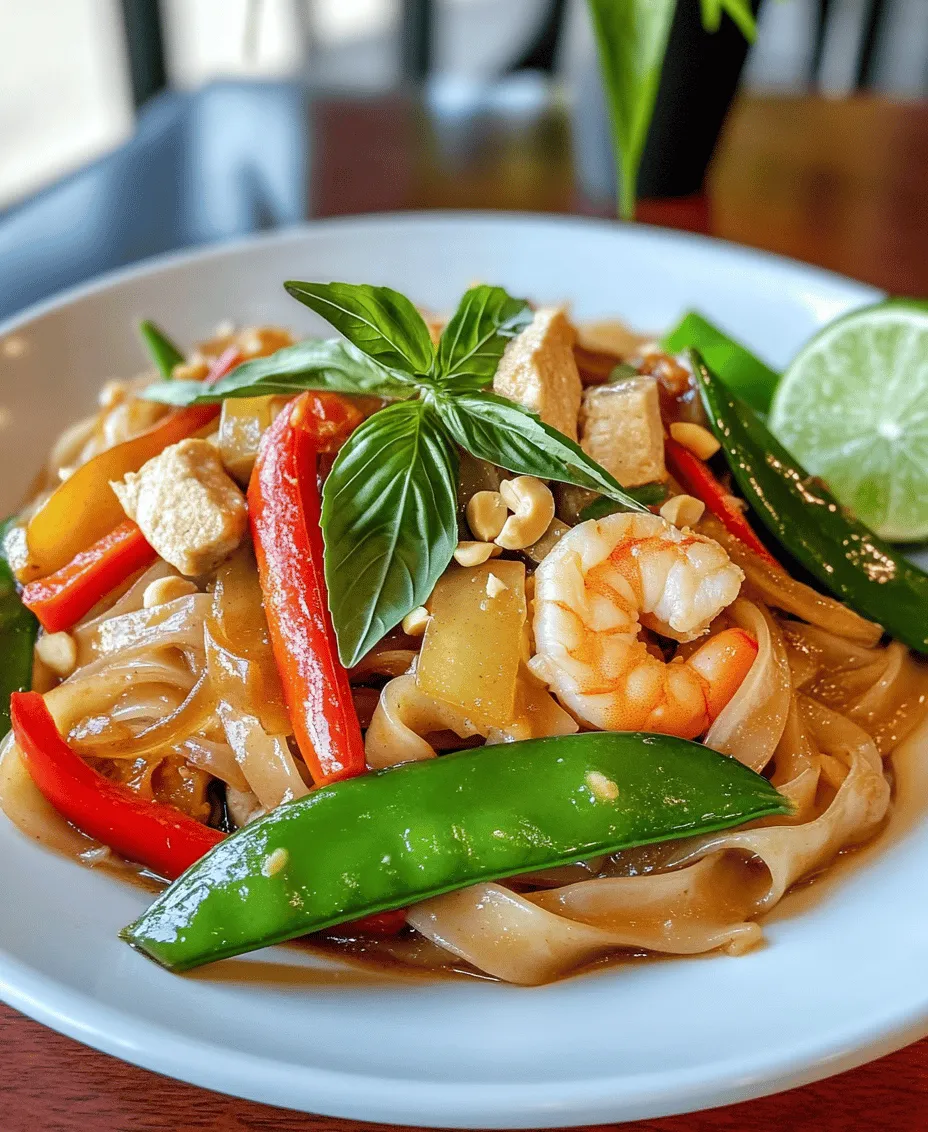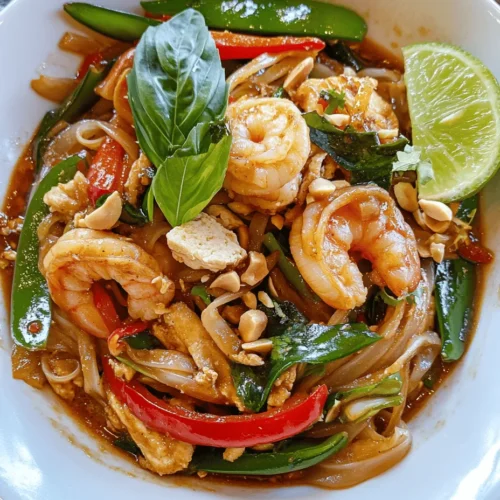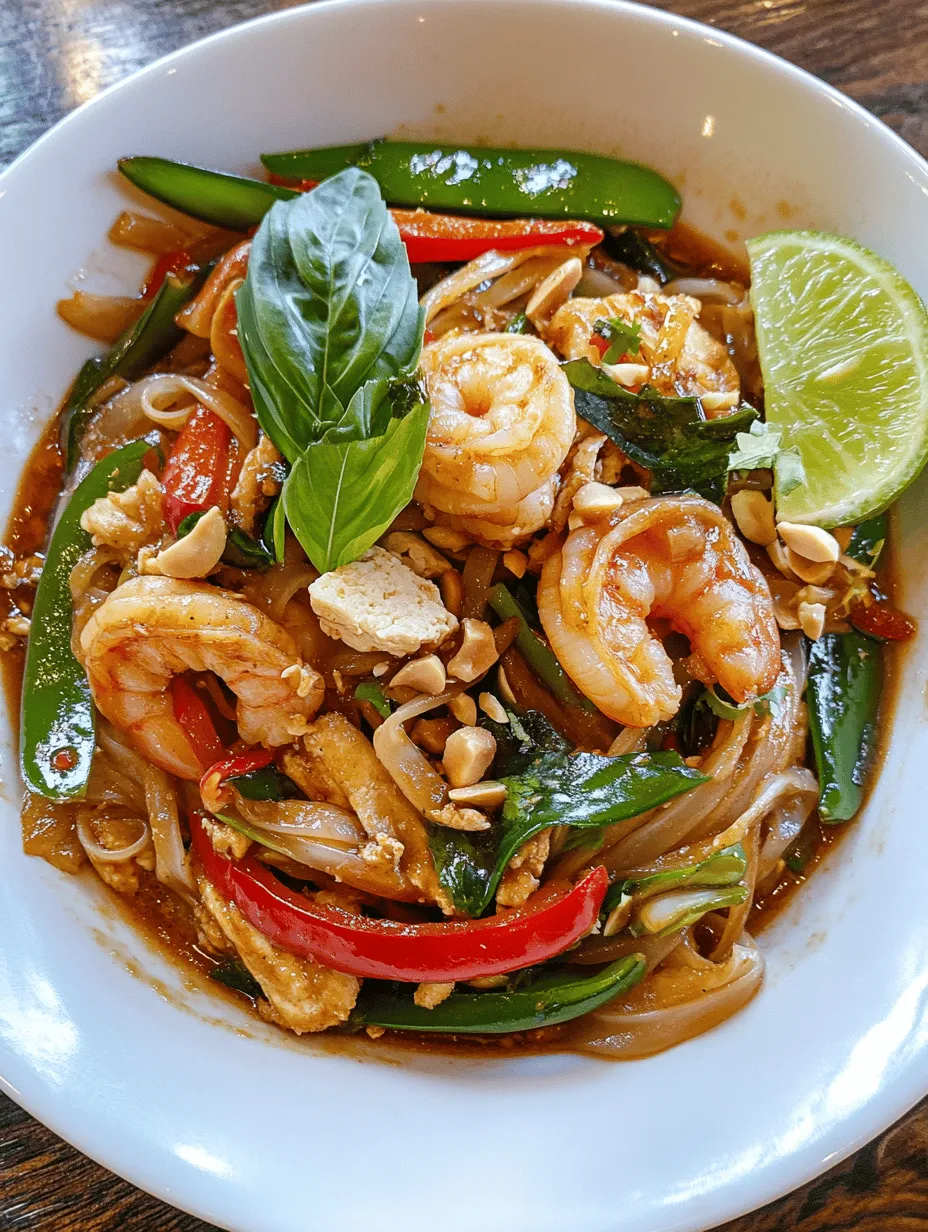Introduction
Drunken Noodles, known as Pad Kee Mao in Thai, is a beloved dish that captures the essence of Thailand’s vibrant culinary landscape. This stir-fried noodle dish is renowned for its bold flavors, aromatic herbs, and delightful textures. Its significance in Thai cuisine goes beyond mere taste; it embodies the spirit of street food culture and the communal joy of sharing a meal with loved ones.
What sets Drunken Noodles apart is its unique blend of spicy, savory, and slightly sweet flavors, combined with a medley of fresh vegetables and protein options. The dish is often characterized by its wide rice noodles, which provide a chewy texture that beautifully absorbs the rich sauces. The appeal of Drunken Noodles lies not only in its robust taste but also in its versatility, allowing for endless variations to suit any palate.
In recent years, Drunken Noodles have gained immense popularity in Thai restaurants around the world. Diners are captivated by the dish’s colorful presentation and complex flavor profile. However, the experience of making Drunken Noodles at home can be equally rewarding. With a few key ingredients and simple techniques, you can recreate this flavorful dish in your own kitchen, bringing the taste of Thailand to your dining table.
This article will guide you through the essential ingredients needed for Drunken Noodles, as well as the preparation methods that ensure a delicious outcome. Whether you’re a seasoned cook or a beginner, you’ll find that this dish is both approachable and satisfying to prepare.
Understanding Drunken Noodles
The origins of Drunken Noodles are steeped in Thai culture, with its name reflecting an intriguing connection to nightlife and street food. The term “Pad Kee Mao” translates to “stir-fried drunk,” which is believed to have originated from the dish’s popularity among late-night revelers seeking a hearty meal after a night of festivities. The combination of bold flavors and satisfying textures makes it a perfect choice for those looking to indulge their appetites.
While the exact history of Drunken Noodles may be difficult to pinpoint, it’s widely accepted that the dish emerged from Thailand’s bustling street food scene. Street vendors often create their own variations of the dish, showcasing local ingredients and flavors. This adaptability has led to Drunken Noodles becoming a staple in both casual eateries and upscale restaurants throughout Thailand.
As with many traditional dishes, Drunken Noodles has several regional variations, each with its own unique twist. Some versions may incorporate different types of protein or vegetables, while others might feature distinct spice levels, reflecting the local palate. Regardless of the variation, the core elements of the dish remain the same: wide rice noodles, an aromatic stir-fry base, and a harmonious blend of sauces.
Ingredient Breakdown
To create an authentic and delicious batch of Drunken Noodles, you’ll need a selection of fresh ingredients. Each component plays a vital role in building the dish’s characteristic flavor and texture. Let’s explore the essential ingredients you’ll need:
Wide Rice Noodles
Wide rice noodles are the foundation of Drunken Noodles. Their chewy texture and ability to absorb flavors make them the perfect vehicle for the aromatic sauces and spices used in the dish. When selecting rice noodles, look for those labeled as “wide” or “thick” — they should be about 1/4 inch wide. You’ll need to cook them until they’re just tender but still have a slight bite, as they will continue to cook during the stir-frying process.
Vegetable Oil
For stir-frying, it’s important to choose the right type of oil. High smoke point oils, such as vegetable oil, canola oil, or peanut oil, are ideal for high-heat cooking. These oils will not only help to prevent sticking but will also enhance the flavors of the other ingredients. Avoid using olive oil, as it has a lower smoke point and can impart an undesirable flavor when heated.
Garlic and Chilies
Garlic and fresh chilies are essential for building an aromatic base in Drunken Noodles. Garlic adds a savory depth, while chilies provide the heat that makes this dish truly exciting. You can choose between Thai bird’s eye chilies for a fiery kick or milder varieties if you prefer less spice. Mince the garlic and slice the chilies thinly to ensure they release their flavors during the stir-frying process.
Vegetables
A colorful assortment of vegetables not only enhances the visual appeal of Drunken Noodles but also contributes valuable nutrients. Common vegetables used in this dish include bell peppers, snap peas, and green beans. Bell peppers add a sweet crunch, while snap peas and green beans provide a fresh snap and vibrant color. Feel free to experiment with other vegetables, such as carrots or bok choy, depending on what you have on hand.
Protein Options
Drunken Noodles can be made with various protein options, including chicken, shrimp, or tofu. Choosing the right protein can influence the dish’s flavor and overall appeal. If you’re using chicken or shrimp, opt for fresh, high-quality options for the best results. Tofu is an excellent vegetarian alternative that absorbs the flavors of the sauces beautifully. For the best texture, be sure to press and drain the tofu before cooking to remove excess moisture.
Sauces
The flavor profile of Drunken Noodles is largely determined by the sauces used. A combination of soy sauce, oyster sauce, and fish sauce creates a complex and savory taste.
– Soy Sauce: Adds saltiness and depth to the dish. Use low-sodium soy sauce if you’re watching your salt intake.
– Oyster Sauce: Provides a rich, slightly sweet flavor that complements the other sauces. If you’re looking for a vegetarian option, there are mushroom-based oyster sauce alternatives available.
– Fish Sauce: This pungent sauce is a staple in Thai cuisine, imparting a unique umami flavor. Use sparingly, as a little goes a long way.
For those wishing to avoid seafood, tamari or soy sauce can be used as substitutes.
Fresh Basil and Lime
Fresh Thai basil is a must-have ingredient to finish the dish and elevate its flavor. Its aromatic notes of anise and mint complement the savory elements of Drunken Noodles beautifully. If Thai basil is not available, sweet basil can be used as a substitute, though the flavor will differ slightly. Additionally, a squeeze of fresh lime juice adds brightness and acidity, balancing the dish’s richness.
Crushed Peanuts
For an optional garnish, crushed peanuts can be sprinkled on top of the finished dish. They add a delightful crunch and nutty flavor that enhances the overall experience. If you’re serving guests with nut allergies, feel free to omit this garnish.
Step-by-Step Cooking Instructions
Now that we have a thorough understanding of the ingredients, it’s time to dive into the cooking process. Preparing Drunken Noodles is a straightforward yet rewarding endeavor. Follow these steps to create a delicious and authentic dish:
Preparation of the Noodles
1. Soak the Noodles: Begin by soaking the wide rice noodles in hot water for about 30 minutes or until they are soft but not fully cooked. This soaking process helps to ensure that the noodles maintain a chewy texture during stir-frying. Once softened, drain the noodles and set them aside.
2. Prepare the Stir-Fry Base: While the noodles are soaking, mince the garlic and slice the chilies. Prepare your vegetables by washing and cutting them into bite-sized pieces for even cooking. If you’re using protein, slice it into thin strips for quick cooking.
3. Combine the Sauces: In a small bowl, mix together the soy sauce, oyster sauce, and fish sauce. This sauce blend will be added to the stir-fried ingredients to create a rich, flavorful coating for the noodles.
Once you have completed these preparation steps, you’ll be ready to move on to the cooking process. Stay tuned for the next part, where we will detail the stir-frying process and how to bring all these ingredients together to create a delicious plate of Drunken Noodles!

Heating the Oil: Best Practices for Achieving the Ideal Stir-Fry Temperature
The foundation of any great stir-fry, including Drunken Noodles, lies in the proper heating of the oil. Start by selecting a high smoke point oil, such as vegetable or peanut oil, to withstand the intense heat required for stir-frying. Pour approximately 2 to 3 tablespoons of oil into a large wok or non-stick skillet, and place it over medium-high heat.
To determine if the oil is hot enough, use the water droplet test: flick a few drops of water into the pan. If they sizzle and evaporate almost immediately, the oil is ready. Achieving this temperature allows for the rapid cooking of the ingredients, creating that signature char and flavor without steaming them. Be cautious not to overheat the oil, as it can lead to burnt flavors and compromised freshness of the dish.
Sautéing Aromatics: Techniques for Maximizing Flavor Extraction from Garlic and Chilies
Once the oil is sizzling, it’s time to infuse it with flavor by sautéing the aromatics. Begin by adding minced garlic and sliced fresh chilies to the pan. The key here is to sauté them quickly over high heat. Stir continuously for about 30 seconds, just until the garlic turns golden and aromatic. This high heat ensures that the garlic releases its essential oils without burning—overcooked garlic can quickly turn bitter.
Adjust the quantity of chilies based on your heat preference. If you prefer a milder version, consider using less or removing the seeds. This method of quickly sautéing these ingredients not only releases their flavors but also creates a fragrant base that will elevate the entire dish.
Adding Vegetables: Timing and Method for Achieving the Perfect Crunch and Flavor
Next, it’s time to add your vegetables. For Drunken Noodles, consider using a mix of colorful bell peppers, snap peas, and carrots. These vegetables not only add texture and color but also contribute significant nutritional value.
Add the vegetables in stages, starting with the ones that take longer to cook, such as carrots. Stir-fry for about 2 minutes before adding the bell peppers and snap peas. The goal is to keep the vegetables crisp; they should remain vibrant and slightly crunchy. This method preserves their nutrients and enhances the dish’s overall flavor profile.
Remember to keep stirring to ensure even cooking. The vibrant colors of the vegetables will provide a feast for the eyes, making your Drunken Noodles even more enticing.
Incorporating Protein: Tips for Ensuring Even Heating and Flavor Distribution
After the vegetables are perfectly sautéed, it’s time to incorporate your choice of protein. Whether you’re using shrimp, chicken, tofu, or beef, ensure that your protein is cut into equal-sized pieces for uniform cooking. If you’re using shrimp, for example, they should be deveined and shelled, while chicken or beef should be thinly sliced against the grain.
Add the protein to the pan once the vegetables are nearly done cooking. Stir-fry for another 3 to 5 minutes, or until the protein is cooked through. This timing ensures that the protein absorbs the flavors of the aromatics and vegetables, resulting in a harmonious blend. For tofu, consider pressing it beforehand to remove excess moisture, allowing it to crisp up beautifully in the pan.
Sauce Mixing: Importance of Whisking and Timing for Optimal Flavor Integration
While the protein is cooking, it’s time to prepare the sauce. In a separate bowl, combine soy sauce, oyster sauce, and a splash of fish sauce. For a vegetarian or vegan option, substitute the oyster sauce with mushroom sauce. Whisk these together thoroughly, as emulsifying the ingredients will create a richer flavor.
Once the protein is ready, pour the sauce over the stir-fry. The key here is timing; adding the sauce at this stage allows it to coat the ingredients evenly while cooking for another minute. Stir continuously to ensure that every ingredient is well-coated, maximizing the flavor integration throughout the dish.
Combining Noodles: Techniques for Tossing and Ensuring Even Coating
Now, it’s time to introduce the star of the dish—your pre-cooked noodles. Whether you choose wide rice noodles or another variety, be sure they are not overly soft; they should retain some bite. Add the noodles directly into the skillet, using tongs or a spatula to gently toss them with the other ingredients.
This step is crucial; use a folding motion to ensure the noodles do not break while mixing. The goal is to achieve an even coating of sauce on each noodle while integrating it with the vegetables and protein. If the mixture seems too dry, consider adding a splash of water or additional soy sauce to loosen it up and enhance the flavor.
Final Touches with Basil and Lime: How to Incorporate Fresh Ingredients Without Losing Their Essence
As the final step, add a generous handful of fresh Thai basil leaves to the mix. The aromatic quality of the basil will contribute to a fresh and vibrant flavor that is characteristic of Drunken Noodles. Toss gently for about 30 seconds to allow the basil to wilt slightly without losing its essential oils.
Finish the dish with a squeeze of fresh lime juice. This bright acidity will balance the savory flavors and elevate the overall experience. The combination of the fragrant basil and zesty lime creates a fresh finish that leaves a lasting impression.
Plating and Presentation: Suggestions for Serving Styles and Garnishing
For plating, consider using a large, shallow bowl or a plate that allows the vibrant colors of your Drunken Noodles to shine. Use a ladle or tongs to create a mound of noodles in the center, allowing the vegetables and protein to cascade over the top.
Garnish with additional basil leaves, a few slices of lime, and even a sprinkle of crushed peanuts for added texture. This not only enhances the presentation but also adds an inviting crunch that complements the dish beautifully.
Nutritional Benefits of Drunken Noodles
Drunken Noodles is not only a treat for the taste buds but also offers a range of nutritional benefits. The variety of vegetables used—such as bell peppers and snap peas—provides essential vitamins and minerals, including vitamin C and fiber. The inclusion of protein, whether from meat or plant-based sources, offers a satisfying and balanced meal.
Balancing flavors is crucial, and incorporating a mix of fresh vegetables contributes to a healthy dish without compromising on taste. To make Drunken Noodles even healthier, consider using whole grain noodles or adding more vegetables to increase the dish’s fiber content.
Variations and Customizations
Drunken Noodles is incredibly versatile and can easily be adapted to suit various dietary preferences. For a vegan version, simply replace animal proteins with tofu or tempeh and ensure all sauces used are free from animal products.
If gluten is a concern, opt for gluten-free soy sauce and rice noodles to create a delicious alternative without sacrificing flavor. Consider experimenting with different proteins, such as shrimp for a seafood twist or chickpeas for a plant-based option.
For a creative spin, try incorporating different herbs or spices to enhance the flavor profile. Adding a dash of curry powder or chili flakes can give your Drunken Noodles an exciting twist that sets them apart from traditional recipes.
Serving Suggestions
Drunken Noodles can stand alone as a satisfying meal, but pairing it with complementary side dishes can elevate the dining experience. Consider serving it alongside a light cucumber salad dressed with rice vinegar or a refreshing Thai papaya salad for a burst of flavor and texture.
In terms of beverages, a chilled Thai iced tea or a light beer can enhance the meal beautifully. Understanding the cultural context of Drunken Noodles in Thai cuisine—which is often enjoyed as a street food staple—can enrich your appreciation for this dish when serving it at home.
Conclusion
Making Drunken Noodles at home is not just about preparing a meal; it’s about embracing the delightful experience of Thai cuisine. The process allows for creativity and customization, ensuring that everyone can enjoy this flavorful dish, regardless of dietary preferences.
The combination of fresh ingredients, vibrant flavors, and the satisfaction of a home-cooked meal makes Drunken Noodles a must-try recipe. So gather your ingredients, follow the steps, and explore the rich tapestry of flavors that this dish has to offer. Dive into the world of Thai cuisine, and enjoy every bite of your homemade Drunken Noodles.



